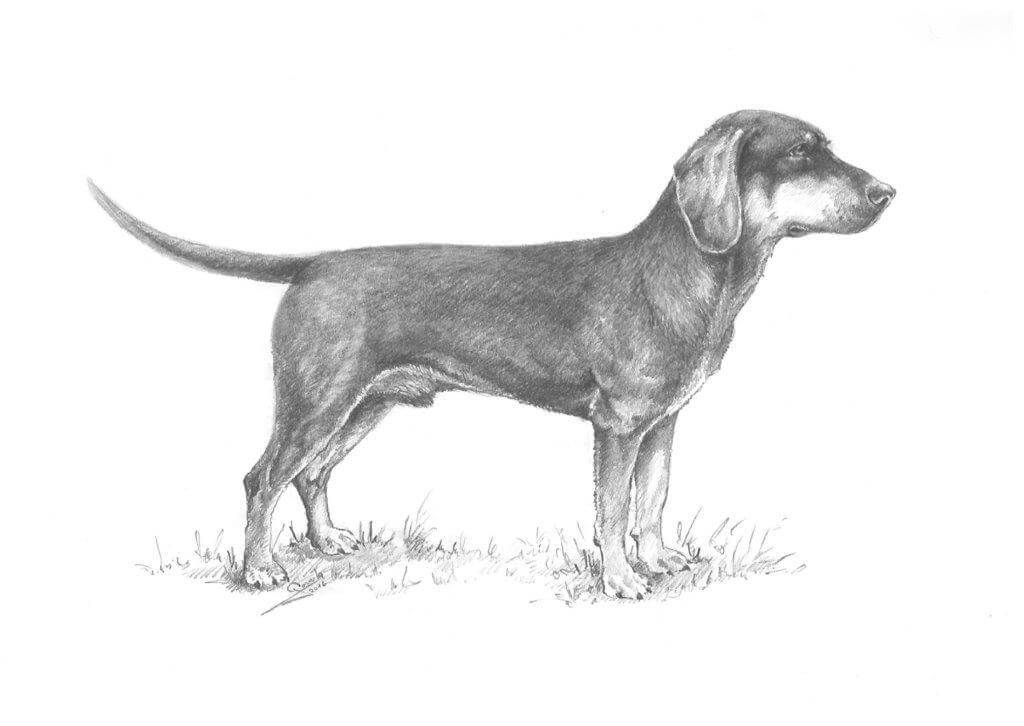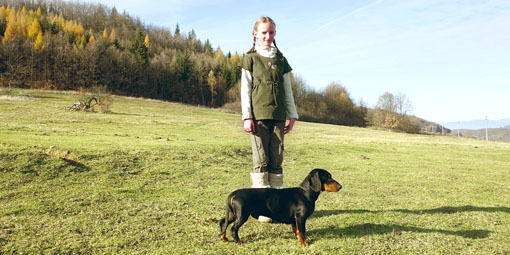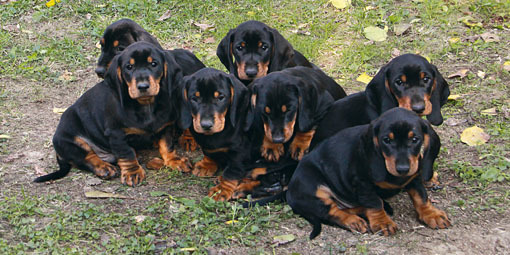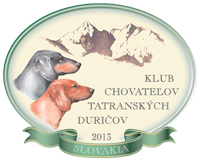Tatras Hound
Origin: Slovakia
DATE OF PUBLICATION OF THE OFFICIAL VALID STANDARD:
UTILIZATION: Hound
FCI-CLASSIFICATION: Group 6 Scent Hounds and related breeds
Section 2 Leash (scent) Hounds
BRIEF HISTORICAL SUMMARY: Hounds, used for hunting game in the mountain regions of Slovakia, have been bred in the country since long ago. Out of these dogs of different types and sizes, a medium sized hound was chosen in the 30s of the 20th century and after a long selection process it was approved as the Slovak Hound (slovenský kopov). Despite many years of selection, there are sometimes puppies of smaller size or a different color in the litters of the Slovak Hound. These were used as a base for creating a hound of smaller size. To enlarge the breeding stock base and to avoid close inbreeding in the first steps of breeding, dogs of other breeds were used, also improving the scent abilities in this breed.
GENERAL APPEARANCE: smaller, lighter in substance, proportional. Enough space between ribcage and ground. Clearly rectangular in shape, strong bones, straight back, slightly pronounced withers, tail straight or saber shaped, carried in the level of topline. Strong, muscular neck, elegant head with a longer ear, not reaching further than the nose.
IMPORTANT PROPORTIONS:
Tatra Hound is a smaller sized breed up to 42 cm in height at withers. The body shape is rectangular, with the ratio of height at withers to the body length being 1:1,25 /males/ to 1:1,3 /females/. For better working abilities the distance between ribcage and ground is important and it should equal ½ of the height at withers.
BEHAVIOR / TEMPERAMENT:
Intelligent, full of temperament, easy to handle, balanced in character, no signs of aggressiveness or fear of his surroundings. Friendly with people. Despite his friendly character, he is eager to work and brave in contact with game. Persistent in his work with a great sense of smell and orientation in the field.
HEAD: Slightly longer than wide. Well-marked stop, which divides the head to approximately same length of skull and muzzle. The lines of muzzle and skull are parallel.
CRANIAL REGION:
Skull: Accordingly wide, slightly rounded top skull with a slightly marked occipital protuberance. Significant superciliary ridges.
Stop: well marked. Divides the upper line of head to two parts of approximately same length.
FACIAL REGION:
Muzzle: Approximately same length as skull. Seen from the side, cannot be square in shape. Symmetrically tapering towards the nose, neither too pointed when looked from the side, nor wedge shaped when looked from above. Bridge of nose straight or slightly convex.
Nose: Sufficient in size, dark in color.
Lips: Well covering the lower jaw, well marked lip corners. Seen from the side, lips make a shape of a distinct curve from the lip corner to the nose.
Jaw/Teeth: Well developed teeth. Incisors well set into the jaw, forming a full curve. Scissor bite. Missing M3 are disregarded.
Cheeks: Full, with well developed muscles.
Eyes: Dark brown or brown, adequate in size, almond in shape. Neither protruding, nor set too deep.
Ears: Medium to long in length, reaching to the tip of the nose. Wider set above the level of eyes. Not too narrow, well rounded. Without folds, hanging loose close to the cheeks.
NECK: Medium length, well muscled, without skin folds. Lower set into the shoulders with a smooth transition to the topline.
BODY:
Topline: firm, level or slightly sloping from withers to root of tail. Withers slightly pronounced, back strong and resilient.
Withers: not too pronounced, smoothly passing to the back
Back: Firm, resilient, very well muscled. Medium length, straight.
Croup: Broad, sufficiently long, slightly rounded. Loin of good length, well muscled, smoothly continuing to the croup. Croup sufficiently long, slightly sloping with a smooth transition to the tail.
Chest: not too wide, sufficiently deep. To keep up with the excellent working attitude of the breed it is not desirable to have a too deep chest. But it is spacious, ribs well rounded, flexible, set slanting. Well developed forechest.
Underline and belly: Underline slightly tucked up. Loins well developed, not too tucked up.
TAIL:
Sufficiently thick and long. Reaching to the hock joint. Set slightly under or in the level of topline. Straight or slightly saber like.
LIMBS:
FOREQUARTERS: straight when looked from both front and from the sides
Shoulder: Well muscled. Shoulder blade sufficiently laid back, well connected to the ribcage. Good angle between the shoulder blade and upper arm.
Upper arm: sufficiently long with a good angulation between the shoulder blade and upper arm letting the dog reach well without getting tired. Well muscled..
Elbow: loose, neither too close to the ribcage, nor too far.
Forearm: long, upright, well muscled
Wrist: strong, smooth.
Pastern: slightly sloping, never steep.
Forefoot: well arched with tight toes. Nails and pads are dark. Pads are thick and firm.
HINDQUARTERS: well angulated when viewed from the side, straight when viewed from behind
.
Thigh: sufficiently long, wide and very well muscled
.
Stifle: strong, tight. Angulation in the stifle and hock joint approximately equal.
Lower thigh: sufficiently long, well muscled
.
Hock joint: tight, smooth and strong
Rear pastern: sinewy, upright when viewed both from the side and from behind.
Hind foot: very well arched and closed. Without dewclaws. Same shape as forefoot.
GAIT / MOVEMENT: smooth and generous in all types of movement. While trotting, the topline is level and the movement of body is elegant. Both front and hind legs are parallel when in action. The most typical movement while working is trot.
SKIN: of medium thickness, elastic, no wrinkles. Well pigmented.
COAT: coarse, close fitting, with sufficient shine. Shorter and softer on the head and limbs.
Color: The Tatra Hound can be found in two color varieties:
Black and tan – black color with exactly bounded tan or reddish markings on head, above the eyes, on the sides of muzzle and lips, on the chest and limbs, around the anus, on the lower side of tail. White markings on chest and limbs are acceptable, also a white spot on the top of the head. On the limbs between the white and the black coat there is some tan coat in between (heritage from old type hounds).
Brown – solid colored brown. The shades vary from light tan to deer red. All with some mixture of black. A black mask on the foreface is sought after, but it is acceptable also without.
SIZE:
Height at withers: Females: 34 – 38 cm
Males: 37 – 42 cm
FAULTS: Any departure from the foregoing points should be considered a fault and the seriousness with which the fault should be regarded should be in exact proportion to its degree and its effect upon the health and welfare of the dog.
SEVERE FAULTS:
Too big or too small dogs or bitches in the relation to the standard size
Poor or absent tan markings in the black and tan colored dogs or bitches
Too light brown coloring
Heavy individuals, lacking elegance.
Too long in shape
Incorrect angulations
Short muzzle, too heavy lips
Short ear. Too hight or too low set ear
Even bite. Absence of more than 2 P1.
DISQUALIFYING FAULTS:
Ectropion, entropion
Overshot or undershot bite
Monorchid, cryptorchid.
Absence of any teeth other than P1 and M3
Every individual showing prominent physical or mental disorders must be disqualified.
N.B.: Male animals should have two apparently normal testicles fully descended into the scrotum.







